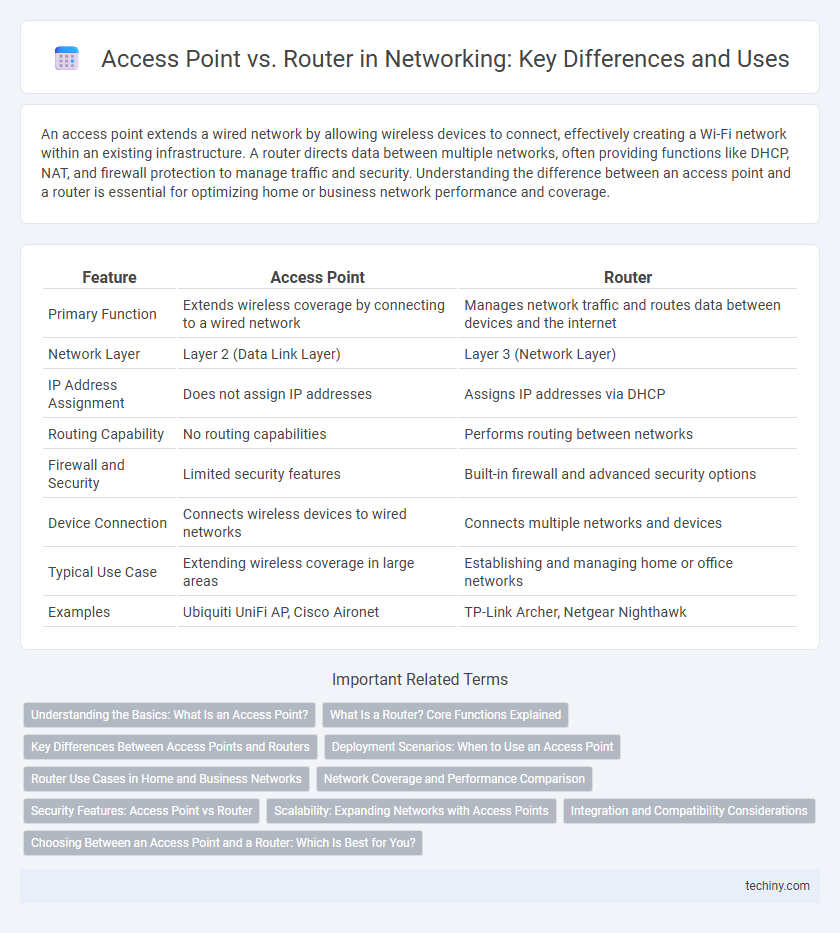An access point extends a wired network by allowing wireless devices to connect, effectively creating a Wi-Fi network within an existing infrastructure. A router directs data between multiple networks, often providing functions like DHCP, NAT, and firewall protection to manage traffic and security. Understanding the difference between an access point and a router is essential for optimizing home or business network performance and coverage.
Table of Comparison
| Feature | Access Point | Router |
|---|---|---|
| Primary Function | Extends wireless coverage by connecting to a wired network | Manages network traffic and routes data between devices and the internet |
| Network Layer | Layer 2 (Data Link Layer) | Layer 3 (Network Layer) |
| IP Address Assignment | Does not assign IP addresses | Assigns IP addresses via DHCP |
| Routing Capability | No routing capabilities | Performs routing between networks |
| Firewall and Security | Limited security features | Built-in firewall and advanced security options |
| Device Connection | Connects wireless devices to wired networks | Connects multiple networks and devices |
| Typical Use Case | Extending wireless coverage in large areas | Establishing and managing home or office networks |
| Examples | Ubiquiti UniFi AP, Cisco Aironet | TP-Link Archer, Netgear Nighthawk |
Understanding the Basics: What Is an Access Point?
An access point (AP) is a networking device that extends a wired network by adding Wi-Fi capabilities, allowing wireless devices to connect to the network. Unlike a router, which directs traffic between different networks and manages IP addressing, an access point primarily provides a bridge between wired and wireless segments within the same network. Understanding the role of an access point is essential for optimizing wireless coverage and ensuring seamless connectivity in both residential and enterprise environments.
What Is a Router? Core Functions Explained
A router is a networking device that directs data packets between different networks, primarily connecting local area networks (LANs) to the internet or other external networks. It manages traffic by assigning IP addresses, routing data efficiently using protocols like DHCP and NAT, and ensuring secure communication through built-in firewalls. Unlike access points that extend wireless coverage, routers serve as the central hub for network management, traffic control, and internet access distribution.
Key Differences Between Access Points and Routers
Access points extend a wired network by creating wireless connections, enabling devices to connect via Wi-Fi without routing traffic between networks. Routers direct data packets between different networks, manage IP addressing through DHCP, and often include built-in security features like firewalls. Unlike access points, routers control traffic between the internet and local devices, while access points primarily increase wireless coverage within an existing network.
Deployment Scenarios: When to Use an Access Point
Access Points are ideal for extending existing wired networks wirelessly in large or multi-story buildings where Ethernet cabling is available but Wi-Fi coverage is insufficient. In enterprise environments, Access Points enable seamless roaming and centralized management, supporting high device density and bandwidth demands. Use Access Points to enhance network scalability and performance without replacing the existing router infrastructure.
Router Use Cases in Home and Business Networks
Routers are essential for managing data traffic between multiple devices and different networks in both home and business environments, ensuring seamless internet access and secure communication. In home networks, routers facilitate wireless connectivity for smartphones, laptops, smart TVs, and IoT devices while enabling parental controls and guest network setup. In business settings, routers support VPNs, firewall integration, and network segmentation to enhance security, optimize bandwidth, and maintain reliable connections across various departments or remote offices.
Network Coverage and Performance Comparison
Access points extend network coverage by connecting to a router and creating additional Wi-Fi zones, enhancing signal strength and reducing dead spots in larger areas. Routers manage traffic between devices and the internet, optimizing network performance by assigning IP addresses, handling data packets, and providing built-in security features. In environments requiring broad coverage and seamless connectivity, combining routers with multiple access points delivers superior performance and expanded network reach.
Security Features: Access Point vs Router
Access points primarily extend wireless coverage without providing advanced security features such as firewall protection or NAT, relying on the router for network security management. Routers incorporate built-in security measures including firewalls, WPA3 encryption, and intrusion detection systems to safeguard the entire network against unauthorized access and cyber threats. Choosing a router with robust security protocols is crucial for protecting sensitive data, while access points serve to maintain secure wireless connectivity within that protected network.
Scalability: Expanding Networks with Access Points
Access points enable scalable network expansion by allowing simultaneous connections across multiple devices without compromising performance, ideal for large or growing environments. Unlike routers, which primarily manage local subnet routing and may become a bottleneck, access points seamlessly extend wireless coverage by integrating into existing infrastructure. Businesses and enterprises benefit from deploying multiple access points to distribute network load efficiently and maintain strong connectivity throughout expansive areas.
Integration and Compatibility Considerations
Access points function as extensions of existing networks, providing seamless integration by connecting directly to routers or switches via Ethernet, ensuring consistent IP management and network policies. Routers, serving as central hubs, incorporate built-in access point functionality but may face compatibility limitations when integrating with third-party wireless devices. Evaluating device compatibility, supported protocols (such as WPA3 and 802.11ax), and management interfaces is crucial for a cohesive and scalable network infrastructure.
Choosing Between an Access Point and a Router: Which Is Best for You?
Choosing between an access point and a router depends on your network expansion needs and existing setup. Access points extend the wireless coverage of an existing network by connecting to a router via Ethernet, ideal for eliminating dead zones in large spaces. Routers manage network traffic, assign IP addresses, and provide firewall protection, making them essential for creating a new network or replacing outdated equipment with integrated routing and wireless capabilities.
Access Point vs Router Infographic

 techiny.com
techiny.com